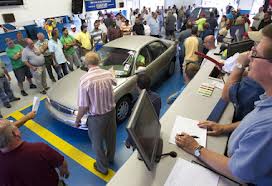There are a lot of different variables which must be considered when buying a used car. One of the easiest things to overlook is the car tires because as long as they are there and adequately inflated, it is easy for the seller to make them “look fine”. Unfortunately, ignoring the car tires can cause a variety of problems. Plus, simply looking at the car tires can provide significant insight into how the car was driven by the prior owner.
How Safe Are Used or Worn Tires?
The first question used-car buyers need to answer is how safe it is to use tires which are noticeably worn. In most cases, buyers will not get a new set of tires were made by used-car whether it’s from the dealership, private seller, or local auto auction. As a result, the used-car will have tires which have noticeable wear on them. This is important to pay attention to because tires can actually lose their grip long before they are worn out.
- Winter Grip
When buying a used car in an area which will see a noticeable amount of severe winter weather, worn tires are particularly problematic. Deep grooves an array of slits are characteristics which help new tires bite into snow. They shall were the tread is, the worse the snow grip will be. In fact, if you accelerate to 20 mph with worn tires it can take an average of 12 V longer to stop.
- Hydroplaning
Similar to winter grip problems, hydroplaning becomes more of a problem as well. Inherently, the faster you drive, the greater risk of hydroplaning becomes. With tires boasting only half tread life, the car will begin to skim over the water surface at as low as 40 mph. This equates to a nearly 8% drop in hydroplaning resistance compared to new tires.
- Wet-Weather Stops
Since hydroplaning is more common with worn tires, it shouldn’t be surprising to learn that it also takes longer to stop and wet weather. In most cases, it will take nearly 3 to 6 feet longer to come to a complete stop from 40 mph when a road is wet if the tires are worn.
- Dry-Road Performance
It is not all bad news. In fact, worn tires actually drive better on dry roads than new tires do. This is because last tread equates to more grit because the shallower grooves put more rubber on the road. This is why racing cars typically run on slicks or troublous tires for maximum traction.
Used Car Buyer Tire Checklist
There are a lot of small details to pay attention to when looking at tires before purchasing a new car. The tires provide significant insight in how a car was driven and how well was maintained. While there are dozens of things to look for, they all fallen to three essential categories.
1. Even Tread Wear
The first thing to look for is even tread wear. If the tread wear is not even across the width of the tread and the same on both sides of the car there is a good chance the tires of not been rotated. If they’ve not been rotated in tread wears typically more severe on the drive wheels. Additionally, aggressive drivers tend to put heavy wear on the outside shoulder of the front tires. This means if you see heavy where there is a chance the car was driven rock. Tires can also show you whether or not the car was typically driven overinflated. Tires which are overinflated tend to wear more in the middle. On the other hand, chronically underinflated tires will wear more on the sides.
2. Sidewall Damage
Another thing to look for is sidewall damage. Any time the appearance of scuffing, cracks, or bulges is obvious there is a good chance the tires will need to be changed soon. This is a key indicator of the vehicle as a whole may not have been well-maintained.
3. Mis-Matched Tires?
A common question used-car buyers have is whether or not it is a good idea to purchase a used car if the tires are mismatched. Ideally, car owners will always change all of their tires at the same time. Unfortunately, mismatched tires is extraordinarily common – primarily due to uneven wear or an unforeseen nail on the road. The primary drawback of mismatched tires is they will lead to uneven tire wear which can affect the cars handling. At the same time, mismatched tires are typically considered a good example of why used-car buyers are rarely in perfect condition and don’t create any inherent problems for used-car buyers.











